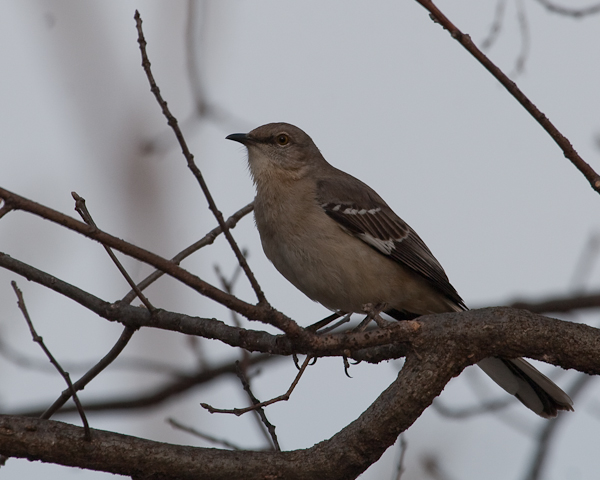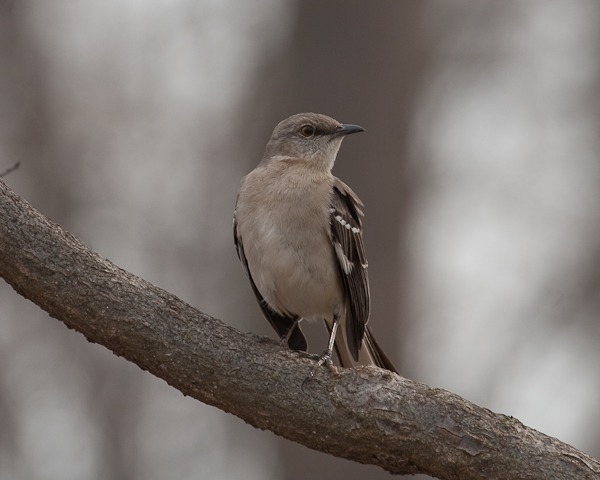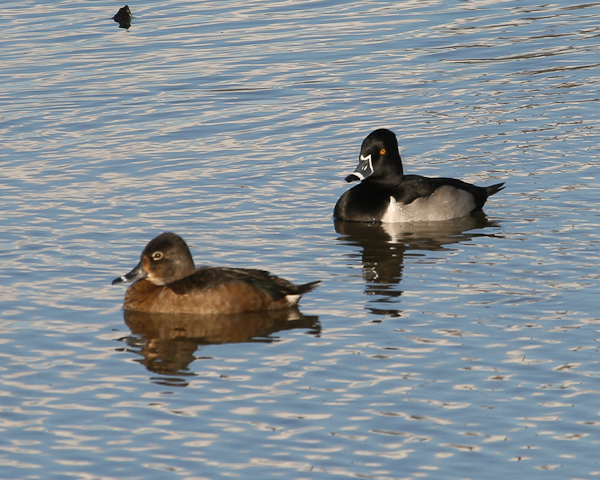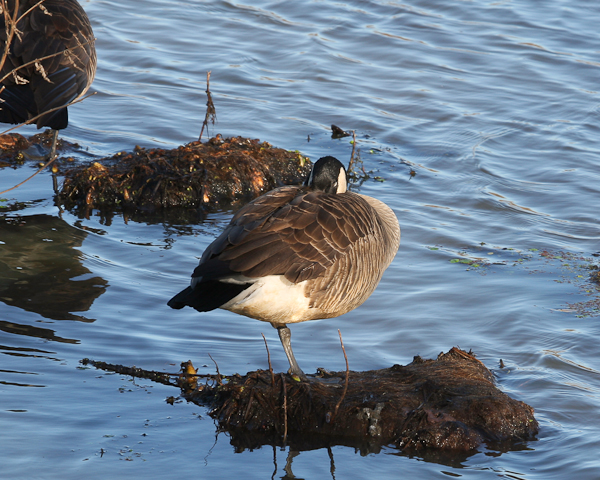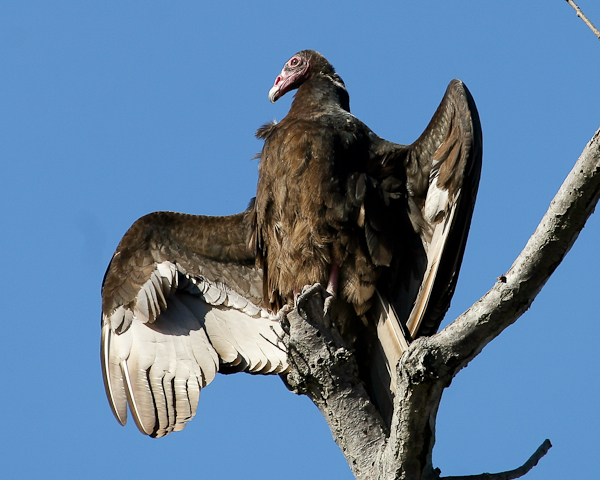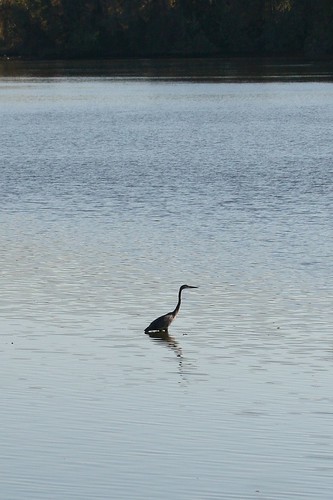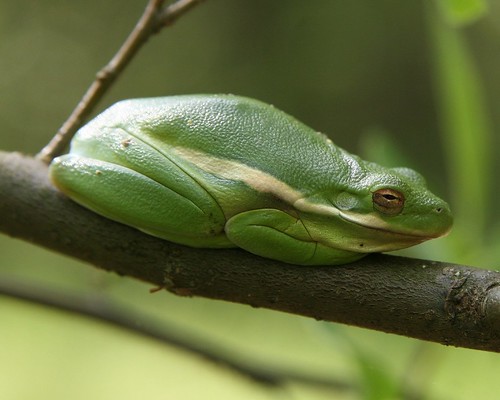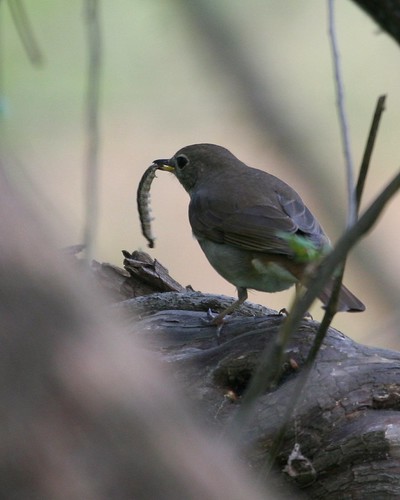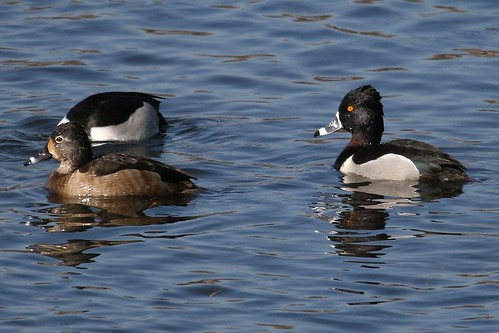A bit like the Eastern Bluebird featured in my previous post, I find myself this week looking at three photographs of Northern Mockingbird. All three photos come from trips to DGCA in the month of March, but I think they might all be of the same bird. When you drive to the visitor center parking lot, there is always a Northern Mockingbird there to greet (scold?) you. He won't let you get too close, but when he perches he sits fairly still (when compared to something like a Blue-gray Gnatcatcher).
I think my neighborhood Northern Mockingbird is nesting in a bush on the edge of my front yard. I was surprised that this post is my first to include photos of a Northern Mockingbird (if you can trust that this blog's tags are accurate...big leap, I fear). Maybe I will get an opportunity or two to snap some photos of young Mockingbirds this spring. I am already thinking of how to prepare for overly defensive parents.
Showing posts with label DGCA. Show all posts
Showing posts with label DGCA. Show all posts
End of the Year
Some free time and a bit of mild weather in December was all the excuse I needed to visit Dutch Gap Conservation Area (DGCA). I am certainly no stranger to DGCA - it is one of my favorite local spots. And while I might occasionally bemoan the repetition of seeing Ring-necked Ducks during the winter, deep down inside I think they are cool looking birds that I really can't resist photographing. Especially when they are at a convenient distance and in good light.
Even a Canada Goose becomes an interesting photographic subject in good light. This one is clearly demonstrating a balancing-while-napping skill that I will never have.
I was on my way out of the park when I spied this lovely Turkey Vulture taking advantage of the morning sunshine. Too good to pass up, I got out of my car and took several photos of this pose, while he watched me for any sign that I might be trouble.
Even a Canada Goose becomes an interesting photographic subject in good light. This one is clearly demonstrating a balancing-while-napping skill that I will never have.
I was on my way out of the park when I spied this lovely Turkey Vulture taking advantage of the morning sunshine. Too good to pass up, I got out of my car and took several photos of this pose, while he watched me for any sign that I might be trouble.
Time Out
I am taking a break from the Alaska photos this week to share a picture or two that I took this past weekend at Dutch Gap Conservation Area (DGCA). Nothing fancy, but it will take a little less time on my part during a week that has a lot less time available for blogging.
DGCA built a bridge this past winter that turned an eight mile out and back into a five mile loop. The weather was really nice this past Saturday, so Tammy and I went out and hiked the new loop. Along the way we found this Great Blue Heron posing ever so nicely next to the far shore.
DGCA built a bridge this past winter that turned an eight mile out and back into a five mile loop. The weather was really nice this past Saturday, so Tammy and I went out and hiked the new loop. Along the way we found this Great Blue Heron posing ever so nicely next to the far shore.
Green Treefrog
In my previous post I shared a picture of a dragonfly consuming a moth. The dragonfly was perched in a sapling next to the trail, but was a bit too high for me to get a reasonable picture. So Tammy played the role of "able assistant" by pulling the top of the sapling over until the dragonfly was at eye level for me. After I had taken my share of photos, she allowed the sapling to return to its natural upright position (gently...we did not want to disturb the dragonfly's meal :-).
I was in the process of swapping lenses on my camera when I noticed something odd about the sapling. There was an odd green lump on it, about a foot higher than the dragonfly. I stared for a second before realizing that the odd green lump was actually a Green Treefrog. Then I realized that the frog had been on the sapling the entire time that I was photographing the dragonfly. Either we were too focused on the dragonfly, or the frog was that well hidden.
I could not pass up the chance to take pictures of this frog. So my "able assistant" once again pulled the sapling over from the top so that my subject was at eye level. The frog sat there, waiting it out, while each of us took our photos. Here he is in all his green glory.
I was in the process of swapping lenses on my camera when I noticed something odd about the sapling. There was an odd green lump on it, about a foot higher than the dragonfly. I stared for a second before realizing that the odd green lump was actually a Green Treefrog. Then I realized that the frog had been on the sapling the entire time that I was photographing the dragonfly. Either we were too focused on the dragonfly, or the frog was that well hidden.
I could not pass up the chance to take pictures of this frog. So my "able assistant" once again pulled the sapling over from the top so that my subject was at eye level. The frog sat there, waiting it out, while each of us took our photos. Here he is in all his green glory.
Dragonflies
For me, a trip outside for the purpose of "bird watching" is really much more than just "bird watching". Sure, I am watching and listening for birds, but I also keep an eye and ear out for other critters. And if some critter actually sits still long enough for me to get a picture, then even better. Such is the case with insects.
While I have not yet invested in a macro lens, I still find opportunity to get fairly close to the occasional bug. Dragonflies are a great example. Sometimes they are skittish and will not tolerate you getting close. But other times they are just hanging out, and that is when I might get a nice up-close photograph.
These two photos are great examples. Both were taken during walks within Dutch Gap Conservation Area (DGCA) in April of this year. The first dragonfly was just sitting on his perch in direct sun. I got as close as my lens would allow (inches away) and snapped a bunch of pictures, and he never budged. The second dragonfly was more interesting. I have never seen this before, but I suppose dragonflies have to eat sometime. This particular dragonfly appeared to be eating what used to be a moth. While he ate, I was able to get fairly close for some photos.
With birds, I have a good chance of identifying them. Not so with dragonflies. I do not own a field guide (yet), so the only way I manage to identify them are getting lucky on another website, or enjoying the charity of other more knowledgeable folks. So, these two are just "dragonflies" for now.
While I have not yet invested in a macro lens, I still find opportunity to get fairly close to the occasional bug. Dragonflies are a great example. Sometimes they are skittish and will not tolerate you getting close. But other times they are just hanging out, and that is when I might get a nice up-close photograph.
These two photos are great examples. Both were taken during walks within Dutch Gap Conservation Area (DGCA) in April of this year. The first dragonfly was just sitting on his perch in direct sun. I got as close as my lens would allow (inches away) and snapped a bunch of pictures, and he never budged. The second dragonfly was more interesting. I have never seen this before, but I suppose dragonflies have to eat sometime. This particular dragonfly appeared to be eating what used to be a moth. While he ate, I was able to get fairly close for some photos.
With birds, I have a good chance of identifying them. Not so with dragonflies. I do not own a field guide (yet), so the only way I manage to identify them are getting lucky on another website, or enjoying the charity of other more knowledgeable folks. So, these two are just "dragonflies" for now.
White-eyed Vireo
Even though I posted a couple photos of a White-eyed Vireo back in March of this year, I have another to post today. The photos I posted in March were from Florida, where they are year round residents. Today's photo is of a migrant passing through DGCA in Virginia this past April.
The sound of vireos in the trees and underbrush is welcome sign that spring has returned. While there is no shortage of the endless singing of Red-eyed Vireos, hearing the "chik purr-ee-ay chik" song of a White-eyed Vireo is little less common and always a special find. This individual was singing his song repeatedly, moving fairly quickly from perch to perch within the confines of a bushy area next to the trail. I stopped, watched and waited with my camera until he eventually came out onto a perch that was not obscured by any vegetation.
The sound of vireos in the trees and underbrush is welcome sign that spring has returned. While there is no shortage of the endless singing of Red-eyed Vireos, hearing the "chik purr-ee-ay chik" song of a White-eyed Vireo is little less common and always a special find. This individual was singing his song repeatedly, moving fairly quickly from perch to perch within the confines of a bushy area next to the trail. I stopped, watched and waited with my camera until he eventually came out onto a perch that was not obscured by any vegetation.
Pileated Woodpecker
On one of my recent walks in DGCA I had a Pileated Woodpecker call from a tree, almost right over my head. Their call is loud. When this particular bird called out from over my head, my heart skipped a beat.
I snapped a few photos of the bird from the interesting perspective I had, and then watched as the bird flew to another (very dead) tree. It was then that I realized its call was to let its mate know that it had returned. She emerged from a nest cavity in the dead tree, and he climbed in. Very cool.
Here is one of my pictures of the male (with the red patch on his cheek), taken while looking nearly straight up.
I snapped a few photos of the bird from the interesting perspective I had, and then watched as the bird flew to another (very dead) tree. It was then that I realized its call was to let its mate know that it had returned. She emerged from a nest cavity in the dead tree, and he climbed in. Very cool.
Here is one of my pictures of the male (with the red patch on his cheek), taken while looking nearly straight up.
Hermit Thrush
When I am in the field there are certain things that I use to help me find birds. First, I rely heavily on bird song. This is very true in the spring when everything is singing away. I am much more likely to detect a singing bird than a silent bird. Sometimes I hear a bird, identify it from its song, but never manage to see it. Learning bird songs has been a huge help in these situations.
Without bird song I rely on movement. If a bird moves, and I see that movement, then I can try to follow it and maybe identify it. Sometimes I see movement in my peripheral vision and then I have to stop, scan and attempt to relocate the bird. Such was the case with this Hermit Thrush.
As I walked the River Trail at DGCA I noticed movement to my right, but when I looked in that direction I did not see what caused it. Apparently I had flushed this Hermit Thrush. He found a new roost and then just sat still. After I noticed the original movement, I stopped and scanned and got lucky. Finding a bird that is just sitting there and watching you without making a sound is just plain lucky. That is the feeling I get when I suddenly notice an owl in a nearby tree who has been watching me for several minutes. And that is the feeling I got with this thrush. Even after I spotted him, he just sat and watched me. I snapped a bunch of photos hoping that some of them would be reasonable. He, on the other hand, eventually got bored of me and decided that a nearby caterpillar was much more interesting. Yummy!
Without bird song I rely on movement. If a bird moves, and I see that movement, then I can try to follow it and maybe identify it. Sometimes I see movement in my peripheral vision and then I have to stop, scan and attempt to relocate the bird. Such was the case with this Hermit Thrush.
As I walked the River Trail at DGCA I noticed movement to my right, but when I looked in that direction I did not see what caused it. Apparently I had flushed this Hermit Thrush. He found a new roost and then just sat still. After I noticed the original movement, I stopped and scanned and got lucky. Finding a bird that is just sitting there and watching you without making a sound is just plain lucky. That is the feeling I get when I suddenly notice an owl in a nearby tree who has been watching me for several minutes. And that is the feeling I got with this thrush. Even after I spotted him, he just sat and watched me. I snapped a bunch of photos hoping that some of them would be reasonable. He, on the other hand, eventually got bored of me and decided that a nearby caterpillar was much more interesting. Yummy!
Swamp Sparrow
The month of April has been full of work, rainy weekends and the first signs of spring migration. On each Friday I would drive home tired from the week and consider my bird watching options. How tired am I? Can I muster myself out of bed either morning of the weekend early enough for some birdwatching? What is the weather going to be? Is it going to rain again? Do I want to go somewhere local or is it time for a trip out to Shenandoah? Is there any house work that simply cannot be ignored any longer?
In April, I was always tired by Friday, but never too tired. It rained a lot, but not constantly. And I did not make any trips out to Shenandoah (I think I will do that next weekend). Instead, I visited Dutch Gap Conservation Area (DGCA) on three successive weekends.
You might think that visiting the same place three weekends in a row would get old. It probably would, if the visits were not in the spring. I have walked the same exact two miles each weekend, and seen lots of the same stuff each time. But I have also noticed changes each time. In my first trip, there were no American Redstarts. Today, American Redstarts were everywhere. The number of White-throated Sparrows that I see each week is less and less as they move north. And it seems like there are dragonflies and butterflies everywhere.
So, here is the first in a series of pictures from my trips to DGCA in April. On the 13th I saw several Swamp Sparrows at various points of my hike. This particular specimen took a few moments to scan its surroundings from the convenient perch of a fallen tree. While it scanned, I found my photographic opportunity.
In April, I was always tired by Friday, but never too tired. It rained a lot, but not constantly. And I did not make any trips out to Shenandoah (I think I will do that next weekend). Instead, I visited Dutch Gap Conservation Area (DGCA) on three successive weekends.
You might think that visiting the same place three weekends in a row would get old. It probably would, if the visits were not in the spring. I have walked the same exact two miles each weekend, and seen lots of the same stuff each time. But I have also noticed changes each time. In my first trip, there were no American Redstarts. Today, American Redstarts were everywhere. The number of White-throated Sparrows that I see each week is less and less as they move north. And it seems like there are dragonflies and butterflies everywhere.
So, here is the first in a series of pictures from my trips to DGCA in April. On the 13th I saw several Swamp Sparrows at various points of my hike. This particular specimen took a few moments to scan its surroundings from the convenient perch of a fallen tree. While it scanned, I found my photographic opportunity.
Eastern Tailed-Blue
When I visited DGCA a few weeks ago, you could feel spring about to happen. My first Yellow-throated Warbler of the year had arrived. Eastern Bluebirds and Tree Swallows were checking out potential nest sites. And there were lots of bugs to be seen. At one point I laid my backpack on the ground so that I could change lenses on my camera and inspect a nest of Eastern Tent Caterpillars. Almost immediately I noticed three or four little blue-gray butterflies flying about and landing on my backpack. They also had a couple orange spots on the trailing end of their wings, and one tiny tail on each wing. When I got back home I used my copy of Kaufman's Field Guide to Butterflies of North America to identify what I had photographed. At first I thought it was some kind of Hairstreak. None really matched, so I looked at the Blues next. The Eastern Tailed-Blue seemed to match my photograph perfectly.
One less LBJ for me
LBJ. Little Brown Job. My field ID skills with sparrows are poor. I have honed those skills some over the years. Everything sparrow is not simply "LBJ" for me anymore, but I find that if it is not Song, White-throated or Chipping, then I am either stumped, or very unsure.
The camera helps. If I can take photos of it, and those photos are reasonably clear, then I can spend lots of time comparing my pictures to other people's pictures. I no longer have to rely on my (highly fallible) memory of the LBJ and its seemingly infinite brown patterns. I can let the picture remember for me.
So it was with my trip to DGCA this past February. There were plenty of sparrows around. Most were White-throated and Song. There was another variety, however, that I knew was neither of those two, but that I could not identify in the field. Nothing rare or spectacular. Just me, taking one more step on the path of improved sparrow identification. I recognized enough differences from what I was used to seeing to not pass them over as the tried-and-true Song or White-throated.
I took a guess (that turned out to be correct). To test my guess, I used the "Bird ID Help Line" thread of the Field Guide: Birds of the World group within Flickr. The answer I got there matched mine. My tiny personal struggle was with the little ol' Savannah Sparrow. Here are two photos of two different Savannah Sparrows, plus a third of a Song Sparrow for comparison. Unfortunately, all three were taken from above the bird, so the markings on the breast are not completely visible. In looking at these pictures, I find it hard to believe that I used to see Savannah Sparrows and likely dismissed them as "just another Song Sparrow". The difference in tail alone is substantial. Next time I am out in the field, I am hoping that I can confidently carve one more sparrow species from the giant, generic pile of LBJs.
The camera helps. If I can take photos of it, and those photos are reasonably clear, then I can spend lots of time comparing my pictures to other people's pictures. I no longer have to rely on my (highly fallible) memory of the LBJ and its seemingly infinite brown patterns. I can let the picture remember for me.
So it was with my trip to DGCA this past February. There were plenty of sparrows around. Most were White-throated and Song. There was another variety, however, that I knew was neither of those two, but that I could not identify in the field. Nothing rare or spectacular. Just me, taking one more step on the path of improved sparrow identification. I recognized enough differences from what I was used to seeing to not pass them over as the tried-and-true Song or White-throated.
I took a guess (that turned out to be correct). To test my guess, I used the "Bird ID Help Line" thread of the Field Guide: Birds of the World group within Flickr. The answer I got there matched mine. My tiny personal struggle was with the little ol' Savannah Sparrow. Here are two photos of two different Savannah Sparrows, plus a third of a Song Sparrow for comparison. Unfortunately, all three were taken from above the bird, so the markings on the breast are not completely visible. In looking at these pictures, I find it hard to believe that I used to see Savannah Sparrows and likely dismissed them as "just another Song Sparrow". The difference in tail alone is substantial. Next time I am out in the field, I am hoping that I can confidently carve one more sparrow species from the giant, generic pile of LBJs.
Ring-necked Duck
Today was a beautiful day, and as I hinted in my previous post, I did make it out for some birdwatching and photography. I took a trip out to one of my favorite local birdwatching spots: Dutch Gap Conservation Area (sometimes referred to as Henricus, because DGCA is right next to the historical site). I am happy to report that, according to the birds, spring has sprung. There were plenty of just returned Tree Swallows flitting about, and I heard and saw my first of season Yellow-throated Warbler. The song of the Yellow-throated Warbler is one of the first I learned, and is one of the first I hear each spring. Whenever I hear it, I think spring and migration.
So, why is this post called "Ring-necked Duck"? I am usually a bit (and sometimes a lot) behind in the steps I follow to cull out what I consider decent photos. Add to that my usual two-posts-a-week blogging pace, and I am typically posting photos that I took a few weeks ago. Today is no exception. Today I am sharing a photo of a Ring-necked Duck that I took on a different visit to DGCA. I did not take this photo today, but back in February when it was colder and there were still lots of ducks bobbing about the marsh, waiting for their cue to head north. I was lucky to have great light, and my photo shows the chestnut colored ring (on the male) from which this species gets its name.
So, why is this post called "Ring-necked Duck"? I am usually a bit (and sometimes a lot) behind in the steps I follow to cull out what I consider decent photos. Add to that my usual two-posts-a-week blogging pace, and I am typically posting photos that I took a few weeks ago. Today is no exception. Today I am sharing a photo of a Ring-necked Duck that I took on a different visit to DGCA. I did not take this photo today, but back in February when it was colder and there were still lots of ducks bobbing about the marsh, waiting for their cue to head north. I was lucky to have great light, and my photo shows the chestnut colored ring (on the male) from which this species gets its name.
Balancing Act
I have just about reached the end of the photos from my July visit to DGCA that I wanted to share here. I have noticed that my visits to DGCA in the warmer months tend to follow this pattern: walk the river trail to where the boardwalk used to be, turn around and return to my vehicle, and then drive further into the park to visit one or both of the marsh overlooks. That visit to the marsh overlooks is where I usually get my last pictures of the day, and there are always turtles. Yep, today is all about turtles.
The turtle that caught my eye is the one doing the stretch-my-arms-and-legs thing on the log. He is laying there on that log, all splayed out and relaxed in the hot sun. It looks to me like he has balanced the bottom of his shell on the log and is sitting there like a perfectly balanced seesaw. One sneeze and he would flip over backwards into the green muck.


The turtle that caught my eye is the one doing the stretch-my-arms-and-legs thing on the log. He is laying there on that log, all splayed out and relaxed in the hot sun. It looks to me like he has balanced the bottom of his shell on the log and is sitting there like a perfectly balanced seesaw. One sneeze and he would flip over backwards into the green muck.


Great Crested Flycatcher - Revisited
A couple posts back I shared a few pictures that I took of a Great Crested Flycatcher using my digiscoping rig, and commented on the results, my technique and my expectations. All in all, my jury is still out on digiscoping, but I am definitely going to be trying it some more. For example, next month Tammy and I are going to spend a week in and around Yellowstone National Park, and I expect that there will be more than a few chances to photograph far away wildlife in a setting that is controlled enough for me to digiscope.
The phrase "controlled enough" is key. I am not skilled enough with the digiscoping rig yet to be able to quickly point to a new, or just moved target, and then get it in focus. I still need a non-trivial amount of time to do that (relative to the time I need when I am simply using my camera with a telephoto lens).
As an example, here are a few more photos of the same Great Crested Flycatcher, but these were not digiscoped. Instead these were taken with my normal camera configuration: hand held Canon EOS 30D + Canon EF 100-400mm 4.5-5.6 L IS. I think the quality of these are better than those I obtained when digiscoping, but more importantly, I would never have even gotten these photos if I had been trying via digiscope. My chosen subject was way too active for me to keep up with it when using the scope.


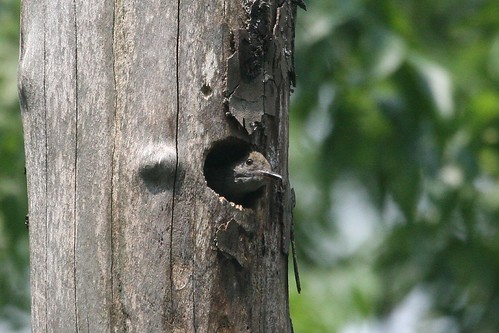
The phrase "controlled enough" is key. I am not skilled enough with the digiscoping rig yet to be able to quickly point to a new, or just moved target, and then get it in focus. I still need a non-trivial amount of time to do that (relative to the time I need when I am simply using my camera with a telephoto lens).
As an example, here are a few more photos of the same Great Crested Flycatcher, but these were not digiscoped. Instead these were taken with my normal camera configuration: hand held Canon EOS 30D + Canon EF 100-400mm 4.5-5.6 L IS. I think the quality of these are better than those I obtained when digiscoping, but more importantly, I would never have even gotten these photos if I had been trying via digiscope. My chosen subject was way too active for me to keep up with it when using the scope.



American Redstart
My recent trip to DGCA yielded yet another opportunity to photograph an American Redstart. This one was nearly eye-level, instead of being way up in a tree, and he was in foliage that was right next to the trail. As he moved through the foliage, I took several photos on a whim, not really confident that I would get anything worth sharing. I was pleasantly surprised, however, to find that this photo was fairly sharp, even if the bird is not presenting his best side and there is some greenery in the way.


Hackberry Emperor
After I finished walking the River Trail at DGCA and had gotten back to my pickup truck, I took off my Camelbak and laid it in the bed of the truck. When I came back around a moment later, a butterfly had landed on the pack and was giving it lots of attention. I had no idea what it was then, but the photo opportunity was excellent because the butterfly was hardly moving.
I did some searching this morning and have determined that this butterfly is a Hackberry Emperor. One of the interesting things I read was that this butterfly likes to "take sweat from humans", which probably explains why it was so interested in my pack.
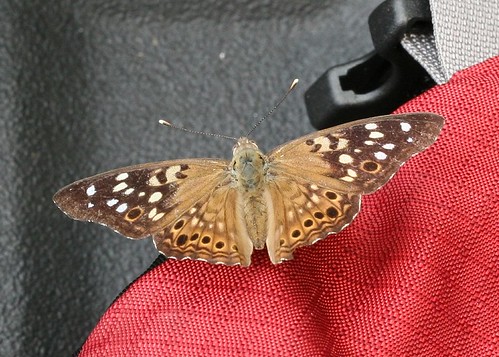
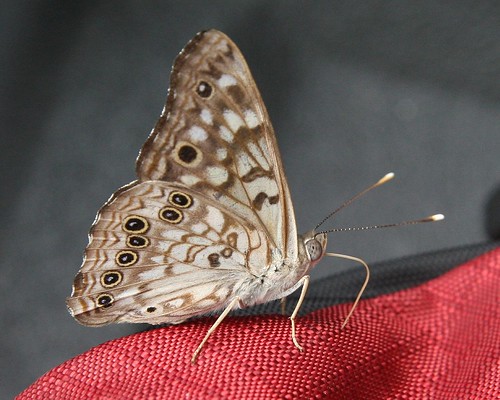
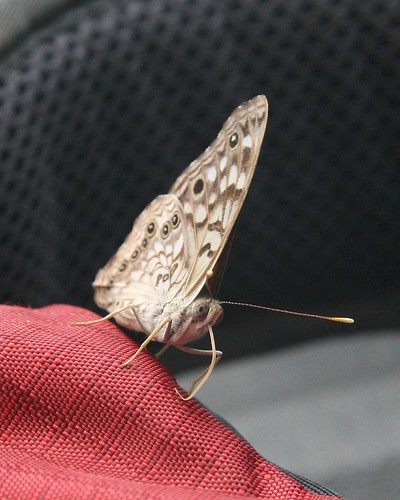
I did some searching this morning and have determined that this butterfly is a Hackberry Emperor. One of the interesting things I read was that this butterfly likes to "take sweat from humans", which probably explains why it was so interested in my pack.



Great Crested Flycatcher
In my previous post, I mentioned that while at DGCA I happened upon a pair of Great Crested Flycatchers tending to a nest. They would both be out searching for food at the same time, each returning to bring nestlings a nice juicy bug. Of course, that is an assumption. I only really saw one bird at a time, so maybe it was the same one each time.
The comings and goings of the flycatchers were good fodder for one of my purposes of this particular trip: practice digiscoping. So I set up my tripod, scope and camera, attached the remote shutter release, and then began trying to get a bird in scope long enough for me to get it in focus and take a few pictures.
The results are varied, with none of the pictures coming out excellent. A few were underexposed. Many were slightly overexposed. None had the bird in super sharp focus. As I hinted in the previous post, I am not sure if I need to change my technique or my expectations. Here are a couple of the photos that I felt were on the better end of the menagerie that I captured.
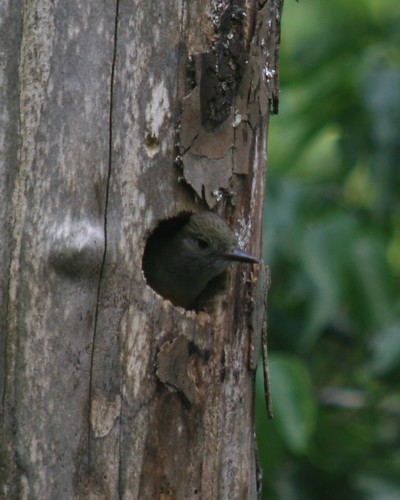

The comings and goings of the flycatchers were good fodder for one of my purposes of this particular trip: practice digiscoping. So I set up my tripod, scope and camera, attached the remote shutter release, and then began trying to get a bird in scope long enough for me to get it in focus and take a few pictures.
The results are varied, with none of the pictures coming out excellent. A few were underexposed. Many were slightly overexposed. None had the bird in super sharp focus. As I hinted in the previous post, I am not sure if I need to change my technique or my expectations. Here are a couple of the photos that I felt were on the better end of the menagerie that I captured.


Basking Lizard
Way back on July 3rd I took the day off from work and visited Dutch Gap Conservation Area (DGCA) to find birds, take photos and to practice digiscoping. While I was practicing the digiscoping with a pair of nesting birds as my subject, I noticed a lizard crawl out onto a nearby tree and begin to soak up some sun. I really did not need to use the digiscoping setup to get pictures of the lizard because it was much closer than the birds, but I also did not want to switch back to my regular photography setup just to get a picture of the lizard (it takes just enough time to be annoying, and is not something you can in a couple seconds).
So, here is the digiscoped lizard in all his glory. He is clinging to the side of a tree in a gravity defying pose, letting the sun re-energize him. Like all of my digiscoped photos, this one is not super sharp (but certainly not blurry). I am trying to figure out if that is user error, gear related, or just the norm for digiscoped photos.

So, here is the digiscoped lizard in all his glory. He is clinging to the side of a tree in a gravity defying pose, letting the sun re-energize him. Like all of my digiscoped photos, this one is not super sharp (but certainly not blurry). I am trying to figure out if that is user error, gear related, or just the norm for digiscoped photos.

Smile for the camera
When I got to the end of the River Trail within DGCA, where the boardwalk used to be, I stood for a few minutes to watch and listen. It was during that time that I noticed several dragonflies (I am pretty sure this is not a damselfly...according to Wikipedia, most dragonflies hold their wings horizontally away from the body). To me, they are always interesting to look at, especially up close. This one looks as if he is aware of me and is smiling for the picture I am taking.
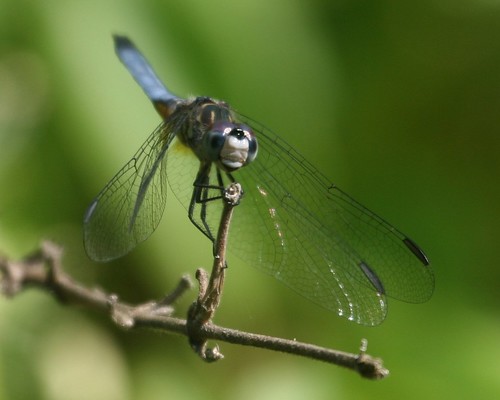

Blackpoll Warbler
While at DGCA I had several opportunities to photograph a Blackpoll Warbler. I made the most that I could out of those opportunities, but the results were not exceptional. Like most warblers, they were quite happy to flit about faster than I could keep up, picking insects off of leaves and branches.
I secretly suspect that they mocked me as they hopped about, moving just as they heard my camera beep-beep when it acquired focus. The joke is on them, however, because the focus was usually acquired on a nearby leaf or branch, not the bird. Ha! Who is laughing now, bouncy Blackpoll?
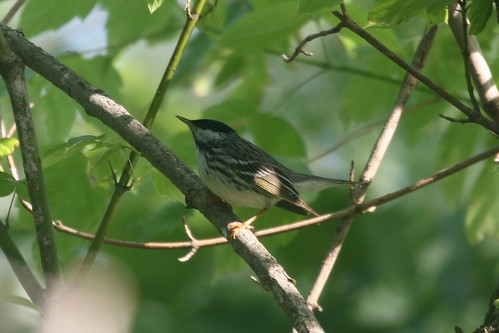
I secretly suspect that they mocked me as they hopped about, moving just as they heard my camera beep-beep when it acquired focus. The joke is on them, however, because the focus was usually acquired on a nearby leaf or branch, not the bird. Ha! Who is laughing now, bouncy Blackpoll?

Subscribe to:
Posts (Atom)
